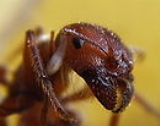
List of animals by number of neurons
Encyclopedia
This is a list of representative animal
s by the number of neuron
s in their whole nervous system
and the number of neurons in their brain
(for those which have a brain). These numbers are estimates derived by multiplying the density of neurons in a particular animal by the average volume of the animal's brain.
s are the cells
which transmit information
in the nervous system
of an animal
so that it can sense
stimuli
coming from its environment and behave
accordingly. Not all animals have neurons; Trichoplax
and sponges lack nerve cells altogether.
Neurons may be packed to form structures such as the brain
of vertebrate
s or the neural ganglions of insect
s.
The number of neurons and their relative abundance in different parts of the brain is a determinant of neural function and, consequently, of behavior.
(although the pallium
of reptiles is also frequently referred to as "cortex".)
Animal
Animals are a major group of multicellular, eukaryotic organisms of the kingdom Animalia or Metazoa. Their body plan eventually becomes fixed as they develop, although some undergo a process of metamorphosis later on in their life. Most animals are motile, meaning they can move spontaneously and...
s by the number of neuron
Neuron
A neuron is an electrically excitable cell that processes and transmits information by electrical and chemical signaling. Chemical signaling occurs via synapses, specialized connections with other cells. Neurons connect to each other to form networks. Neurons are the core components of the nervous...
s in their whole nervous system
Nervous system
The nervous system is an organ system containing a network of specialized cells called neurons that coordinate the actions of an animal and transmit signals between different parts of its body. In most animals the nervous system consists of two parts, central and peripheral. The central nervous...
and the number of neurons in their brain
Brain
The brain is the center of the nervous system in all vertebrate and most invertebrate animals—only a few primitive invertebrates such as sponges, jellyfish, sea squirts and starfishes do not have one. It is located in the head, usually close to primary sensory apparatus such as vision, hearing,...
(for those which have a brain). These numbers are estimates derived by multiplying the density of neurons in a particular animal by the average volume of the animal's brain.
Overview
NeuronNeuron
A neuron is an electrically excitable cell that processes and transmits information by electrical and chemical signaling. Chemical signaling occurs via synapses, specialized connections with other cells. Neurons connect to each other to form networks. Neurons are the core components of the nervous...
s are the cells
Cell (biology)
The cell is the basic structural and functional unit of all known living organisms. It is the smallest unit of life that is classified as a living thing, and is often called the building block of life. The Alberts text discusses how the "cellular building blocks" move to shape developing embryos....
which transmit information
Information
Information in its most restricted technical sense is a message or collection of messages that consists of an ordered sequence of symbols, or it is the meaning that can be interpreted from such a message or collection of messages. Information can be recorded or transmitted. It can be recorded as...
in the nervous system
Nervous system
The nervous system is an organ system containing a network of specialized cells called neurons that coordinate the actions of an animal and transmit signals between different parts of its body. In most animals the nervous system consists of two parts, central and peripheral. The central nervous...
of an animal
Animal
Animals are a major group of multicellular, eukaryotic organisms of the kingdom Animalia or Metazoa. Their body plan eventually becomes fixed as they develop, although some undergo a process of metamorphosis later on in their life. Most animals are motile, meaning they can move spontaneously and...
so that it can sense
Sense
Senses are physiological capacities of organisms that provide inputs for perception. The senses and their operation, classification, and theory are overlapping topics studied by a variety of fields, most notably neuroscience, cognitive psychology , and philosophy of perception...
stimuli
Stimulus (physiology)
In physiology, a stimulus is a detectable change in the internal or external environment. The ability of an organism or organ to respond to external stimuli is called sensitivity....
coming from its environment and behave
Behavior
Behavior or behaviour refers to the actions and mannerisms made by organisms, systems, or artificial entities in conjunction with its environment, which includes the other systems or organisms around as well as the physical environment...
accordingly. Not all animals have neurons; Trichoplax
Trichoplax
The Placozoa are a basal form of invertebrate. They are the simplest in structure of all non-parasitic multicellular animals . They are generally classified as a single species, Trichoplax adhaerens, although there is enough genetic diversity that it is likely that there are multiple,...
and sponges lack nerve cells altogether.
Neurons may be packed to form structures such as the brain
Brain
The brain is the center of the nervous system in all vertebrate and most invertebrate animals—only a few primitive invertebrates such as sponges, jellyfish, sea squirts and starfishes do not have one. It is located in the head, usually close to primary sensory apparatus such as vision, hearing,...
of vertebrate
Vertebrate
Vertebrates are animals that are members of the subphylum Vertebrata . Vertebrates are the largest group of chordates, with currently about 58,000 species described. Vertebrates include the jawless fishes, bony fishes, sharks and rays, amphibians, reptiles, mammals, and birds...
s or the neural ganglions of insect
Insect
Insects are a class of living creatures within the arthropods that have a chitinous exoskeleton, a three-part body , three pairs of jointed legs, compound eyes, and two antennae...
s.
The number of neurons and their relative abundance in different parts of the brain is a determinant of neural function and, consequently, of behavior.
Whole nervous system
| Name | Neurons in the brain/whole nervous system | Details | Image | Source |
| Sponge | 0 |  |
||
| Trichoplax Trichoplax The Placozoa are a basal form of invertebrate. They are the simplest in structure of all non-parasitic multicellular animals . They are generally classified as a single species, Trichoplax adhaerens, although there is enough genetic diversity that it is likely that there are multiple,... |
0 | 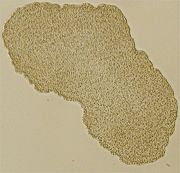 |
||
| Caenorhabditis elegans Caenorhabditis elegans Caenorhabditis elegans is a free-living, transparent nematode , about 1 mm in length, which lives in temperate soil environments. Research into the molecular and developmental biology of C. elegans was begun in 1974 by Sydney Brenner and it has since been used extensively as a model... (roundworm) |
302 |  |
||
| Medicinal leech Leech Leeches are segmented worms that belong to the phylum Annelida and comprise the subclass Hirudinea. Like other oligochaetes such as earthworms, leeches share a clitellum and are hermaphrodites. Nevertheless, they differ from other oligochaetes in significant ways... |
10,000 | 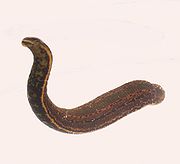 |
||
| Pond snail Snail Snail is a common name applied to most of the members of the molluscan class Gastropoda that have coiled shells in the adult stage. When the word is used in its most general sense, it includes sea snails, land snails and freshwater snails. The word snail without any qualifier is however more often... |
11,000 | 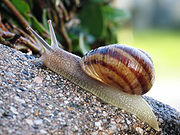 |
||
| Sea slug California sea slug The California sea hare also known as the California sea slug, scientific name Aplysia californica, is a species of sea slug, specifically a sea hare, a marine opisthobranch gastropod mollusk in the sea hare family, Aplysiidae.... |
18,000 | 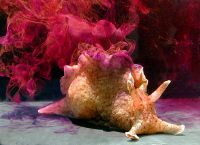 |
||
| Fruit fly Drosophila melanogaster Drosophila melanogaster is a species of Diptera, or the order of flies, in the family Drosophilidae. The species is known generally as the common fruit fly or vinegar fly. Starting from Charles W... |
100,000 | .jpg) |
||
| Lobster Lobster Clawed lobsters comprise a family of large marine crustaceans. Highly prized as seafood, lobsters are economically important, and are often one of the most profitable commodities in coastal areas they populate.Though several groups of crustaceans are known as lobsters, the clawed lobsters are most... |
100,000 | |||
| Ant Ant Ants are social insects of the family Formicidae and, along with the related wasps and bees, belong to the order Hymenoptera. Ants evolved from wasp-like ancestors in the mid-Cretaceous period between 110 and 130 million years ago and diversified after the rise of flowering plants. More than... |
250,000 | Varies per species | 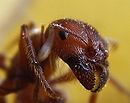 |
|
| Honey bee Honey bee Honey bees are a subset of bees in the genus Apis, primarily distinguished by the production and storage of honey and the construction of perennial, colonial nests out of wax. Honey bees are the only extant members of the tribe Apini, all in the genus Apis... |
960,000 | 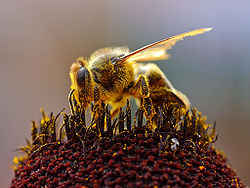 |
||
| Cockroach Cockroach Cockroaches are insects of the order Blattaria or Blattodea, of which about 30 species out of 4,500 total are associated with human habitations... |
1,000,000 | 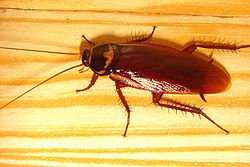 |
||
| Frog Frog Frogs are amphibians in the order Anura , formerly referred to as Salientia . Most frogs are characterized by a short body, webbed digits , protruding eyes and the absence of a tail... |
16,000,000 | 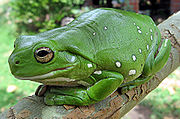 |
||
| Mouse Mouse A mouse is a small mammal belonging to the order of rodents. The best known mouse species is the common house mouse . It is also a popular pet. In some places, certain kinds of field mice are also common. This rodent is eaten by large birds such as hawks and eagles... |
75,000,000 |  |
||
| Octopus Octopus The octopus is a cephalopod mollusc of the order Octopoda. Octopuses have two eyes and four pairs of arms, and like other cephalopods they are bilaterally symmetric. An octopus has a hard beak, with its mouth at the center point of the arms... |
300,000,000 | 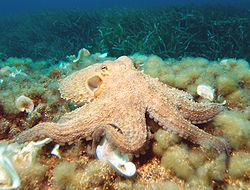 |
||
| Human Human Humans are the only living species in the Homo genus... |
100,000,000,000 | For average adult | ||
| Elephant Elephant Elephants are large land mammals in two extant genera of the family Elephantidae: Elephas and Loxodonta, with the third genus Mammuthus extinct... |
200,000,000,000 |
Cerebral cortex
Only mammals appear in this list, because only mammals have a cerebral cortexCerebral cortex
The cerebral cortex is a sheet of neural tissue that is outermost to the cerebrum of the mammalian brain. It plays a key role in memory, attention, perceptual awareness, thought, language, and consciousness. It is constituted of up to six horizontal layers, each of which has a different...
(although the pallium
Pallium (neuroanatomy)
In a neuroanatomy context, the word pallium refers to the layers of gray and white matter that cover the upper surface of the telencephalon in vertebrates. The non-pallial part of the telencephalon builds the subpallium. In basal vertebrates the pallium is a relatively simple three-layered...
of reptiles is also frequently referred to as "cortex".)
| Name | Neurons in the cerebral cortex | Details | Image | Source |
| Mouse Mouse A mouse is a small mammal belonging to the order of rodents. The best known mouse species is the common house mouse . It is also a popular pet. In some places, certain kinds of field mice are also common. This rodent is eaten by large birds such as hawks and eagles... |
4,000,000 |  |
||
| Rat Rat Rats are various medium-sized, long-tailed rodents of the superfamily Muroidea. "True rats" are members of the genus Rattus, the most important of which to humans are the black rat, Rattus rattus, and the brown rat, Rattus norvegicus... |
21,000,000 | 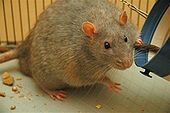 |
||
| Dog Dog The domestic dog is a domesticated form of the gray wolf, a member of the Canidae family of the order Carnivora. The term is used for both feral and pet varieties. The dog may have been the first animal to be domesticated, and has been the most widely kept working, hunting, and companion animal in... |
160,000,000 | 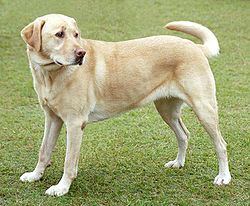 |
||
| Cat Cat The cat , also known as the domestic cat or housecat to distinguish it from other felids and felines, is a small, usually furry, domesticated, carnivorous mammal that is valued by humans for its companionship and for its ability to hunt vermin and household pests... |
300,000,000 | 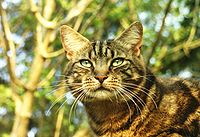 |
||
| Dolphin Dolphin Dolphins are marine mammals that are closely related to whales and porpoises. There are almost forty species of dolphin in 17 genera. They vary in size from and , up to and . They are found worldwide, mostly in the shallower seas of the continental shelves, and are carnivores, mostly eating... |
5,800,000,000 |  |
||
| Chimpanzee Chimpanzee Chimpanzee, sometimes colloquially chimp, is the common name for the two extant species of ape in the genus Pan. The Congo River forms the boundary between the native habitat of the two species:... |
6,200,000,000 | 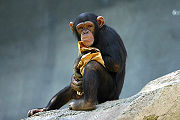 |
||
| Human Human Humans are the only living species in the Homo genus... |
11,000,000,000 | For average adult | ||
| Fin whale Fin Whale The fin whale , also called the finback whale, razorback, or common rorqual, is a marine mammal belonging to the suborder of baleen whales. It is the second longest whale and the sixth largest living animal after the blue whale, bowhead whale, and right whales, growing to nearly 27 metres long... |
15,000,000,000 |  |
||
| Pilot whale Pilot whale Pilot whales are cetaceans belonging to the genus Globicephala. There are two extant species, the long-finned pilot whale and the short-finned pilot whale . The two are not readily distinguished at sea and analysis of the skulls is the best way to tell the difference between them... |
30,000,000,000 |
See also
- Lists of animals
- Brain sizeBrain sizeBrain size is one aspect of animal anatomy and evolution. Both overall brain size and the size of substructures have been analysed, and the question of links between size and functioning - particularly intelligence - has often proved controversial...
- Brain-to-body mass ratio
- ConnectomeConnectomeA connectome is a comprehensive map of neural connections in the brain.The production and study of connectomes, known as connectomics, may range in scale from a detailed map of the full set of neurons and synapses within part or all of the nervous system of an organism to a macro scale description...
- ConnectomicsConnectomicsConnectomics is a high-throughput application of neural imaging and histological techniques in order to increase the speed, efficiency, and resolution of maps of the multitude of neural connections in a nervous system...
- Cranial capacityCranial capacityCranial capacity is a measure of the volume of the interior of the cranium of those vertebrates who have both a cranium and a brain. The most commonly used unit of measure is the cubic centimetre or cc...

